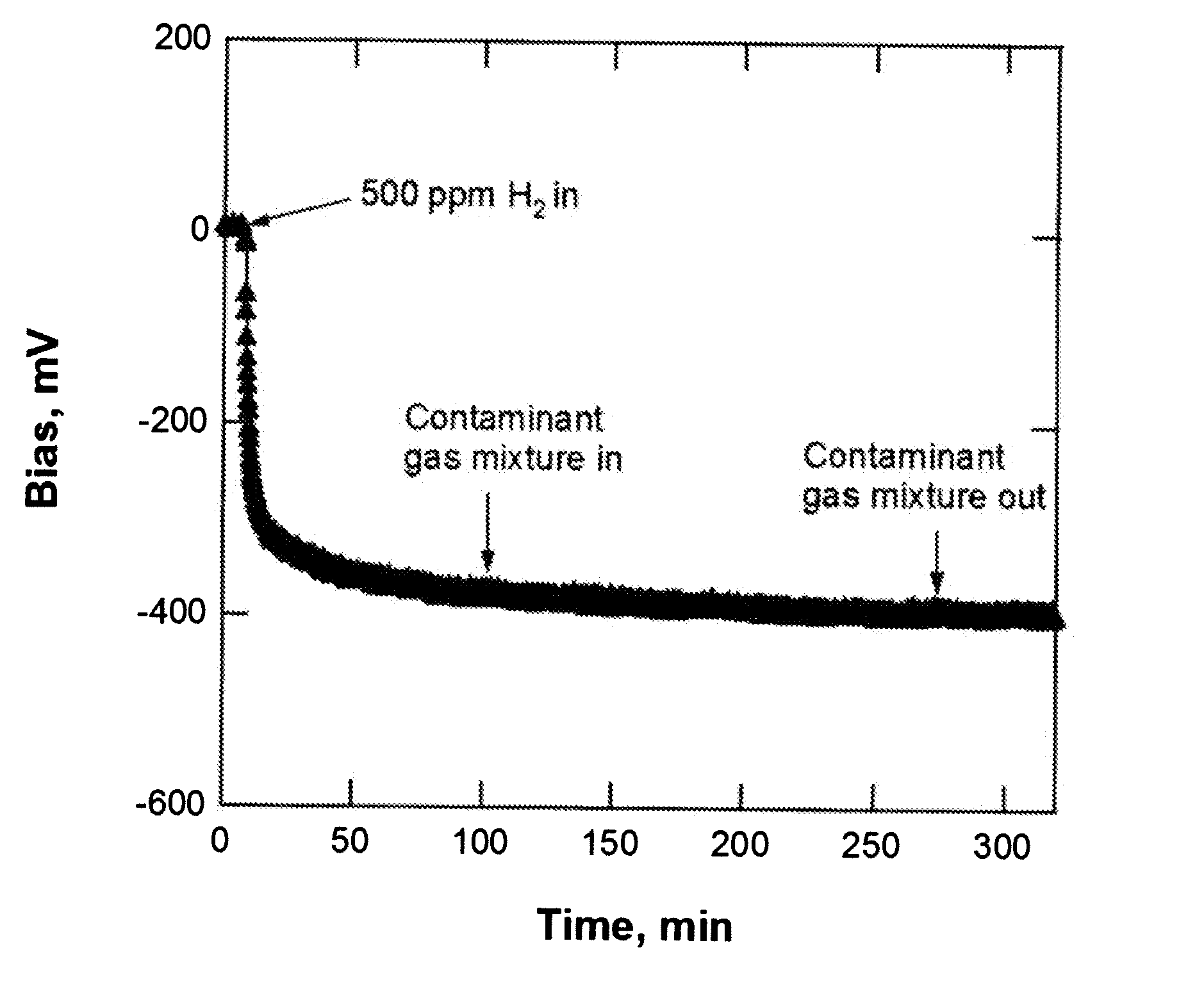Mis-based sensors with hydrogen selectivity
a technology of hydrogen selectivity and sensors, applied in the field of misbased sensors, can solve the problems of generating “fault gases”, reducing and reducing the detection accuracy of gases dissolved in liquids, etc., and achieves dramatic shift in sensor response, reduce response, and large effect on the response of coated sensors
- Summary
- Abstract
- Description
- Claims
- Application Information
AI Technical Summary
Benefits of technology
Problems solved by technology
Method used
Image
Examples
example 1
Mis Device Fabrication
[0068] The Compound Semiconductor Research Laboratory (CSRL) at Sandia National Laboratories (New Mexico) prepared the Pd / SiO2 / n-Si capacitors used for this work. These capacitors were fabricated in a similar manner as described in previous publications, which yielded a similar overall device structure R. C. Hughes, R. Bastasz, W. P. Ellis, Hydrogen sensing in vacuum systems with catalytic field plate MNOS capacitors, Appl. Surf. Sci. 115 (1997) 74. A 50 nm Pd film was deposited by electron-beam evaporation on a 50 nm layer of SiO2 prepared by thermal oxidation of the Si wafer. Auger electron spectroscopy depth profiling was applied to analyze samples from each production batch to verify film composition.
[0069] A spin-coating technique was applied to add an attached layer of polyimide (PI)-2555 (a reaction product of benzophenone tetracarboxylic dianhydride 4,4-oxydianiline m-phenylene diamine, BTDA-ODA-MPD; purchased from DuPont HD Microsystems™) to the top ...
example 2
Sensor Response to Hydrogen, Contaminant Gas and Hydrogen / Contaminant Gas Mixtures
[0070] Each sensor to be tested was mounted on a sample holder that was inserted in a gas flow cell. Electrical leads for sensor heating were attached to the capacitor base and sensor bond pads. Resistive heating for the mounted sensor was achieved via a conductive button heater (HeatWave Labs Inc.) and the sensor temperature was measured by a thermocouple spot-welded to the heater body. The surface temperature of the sensor has been measured to be within 3° C. of the heater body temperature. The sample holder and flow cell configurations have been discussed in a previous publication (J. W. Medlin, A. H. McDaniel, M. A. Allendorf, R. Bastasz, Effects of competitive CO adsorption on the hydrogen response of MIS sensors: the role of metal film morphology, J. Appl. Phys. 93 (2003) 2267). Shifts in the C-V curve of each capacitor were measured using a program that records the voltage shift required to mai...
example 3
Sensor Response to CO and Hydrogen / CO Mixtures
[0074] As a further illustration of the effect of contaminant gases on the response of uncoated and coated sensors, experiments were conducted in which CO alone was introduced as a contaminant gas. The effect of CO provides an interesting special case because CO itself is not generally detected by MIS devices; however, it can still affect response to H2 and other gases through strong competitive adsorption on the Pd surface. For example, the rate of response of uncoated MIS devices to H2 is well-known to be dramatically slowed by the presence of even ppm levels of CO because of strong adsorption (poisoning) by CO(M. Eriksson, L.-G. Ekedahl, The influence of CO on the response of hydrogen sensitive Pd-MOS devices, Sens. Actuators B 42 (1997) 217; M. Eriksson, L.-G. Ekedahl, Real time measurements of hydrogen desorption and absorption during CO exposures of Pd: hydrogen sticking and dissolution, Appl. Surf. Sci. 133 (1998) 89). The relati...
PUM
 Login to View More
Login to View More Abstract
Description
Claims
Application Information
 Login to View More
Login to View More - R&D
- Intellectual Property
- Life Sciences
- Materials
- Tech Scout
- Unparalleled Data Quality
- Higher Quality Content
- 60% Fewer Hallucinations
Browse by: Latest US Patents, China's latest patents, Technical Efficacy Thesaurus, Application Domain, Technology Topic, Popular Technical Reports.
© 2025 PatSnap. All rights reserved.Legal|Privacy policy|Modern Slavery Act Transparency Statement|Sitemap|About US| Contact US: help@patsnap.com



